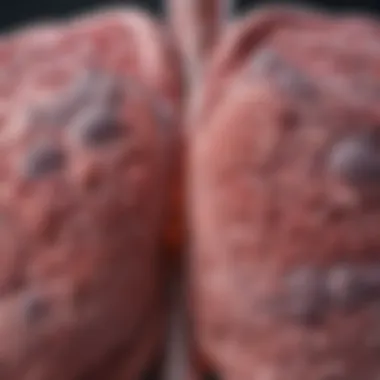Granulomatous Lung Disease Treatment Overview


Intro
Granulomatous lung disease encompasses a variety of pulmonary conditions that are marked by the formation of granulomas. These structures result from the immune system's response to persistent pathogens or irritants. Understanding the etiology and treatment of this complex group of disorders is crucial for effective patient management. This article seeks to provide a comprehensive overview of granulomatous lung disease treatment, with a meaningful emphasis on tailored therapeutic strategies.
Background and Context
Overview of the Research Topic
Granulomatous lung diseases may stem from infectious origins, such as tuberculosis or fungal infections, or non-infectious causes, including sarcoidosis and hypersensitivity pneumonitis. The diversity of these conditions complicates both diagnosis and management. Accurate identification relies on a multifaceted approach that includes patient history, imaging studies, and often, lung biopsy.
Historical Significance
The recognition of granulomatous lung disease dates back several centuries. Early physicians observed the presence of granulomas in various conditions, yet the mechanisms remain partly elucidated. Over the past few decades, research has evolved, leading to improved diagnostic methods and a better understanding of treatment modalities.
Key Findings and Discussion
Major Results of the Study
Research shows that treatment approaches can be broadly classified into pharmacological and non-pharmacological strategies. Pharmacological treatment typically includes corticosteroids and immunosuppressants, aimed at controlling inflammation and preventing tissue damage. Non-pharmacological methods may involve lifestyle changes, pulmonary rehabilitation, and even surgical interventions when necessary.
Detailed Analysis of Findings
- Pharmacological Interventions:
- Non-Pharmacological Approaches:
- Corticosteroids are often the first line of treatment for many granulomatous conditions. Their anti-inflammatory properties are well-documented but come with potential side effects such as osteoporosis and increased infection risk.
- Immunosuppressants like methotrexate or azathioprine may be used when corticosteroids are insufficient or to minimize their dosage.
- Lifestyle Modifications: Smoking cessation and addressing environmental pollutants contribute significantly to managing symptoms.
- Pulmonary Rehabilitation: This program can help improve lung function through exercise and education.
- Surgical Options: In severe cases, surgical resection of damaged lung tissue may be necessary.
Collaboration among healthcare professionals is vital. A multidisciplinary team that may involve pulmonologists, rheumatologists, and primary care physicians is essential for optimal patient outcomes.
The importance of individualized treatment plans cannot be overstated. Each case presents unique challenges and requires tailored strategies based on the specific condition and patient factors.
Through this comprehensive overview, the goal is to furnish healthcare providers and informed readers with a detailed understanding of granulomatous lung diseases and their treatment options. The dynamic nature of this field necessitates ongoing research and education to improve patient care.
Preamble to Granulomatous Lung Disease
Granulomatous lung disease encompasses a variety of pulmonary conditions defined by the formation of granulomas. These small aggregates of macrophages arise in response to chronic inflammation, often as a reaction to various irritants or pathogens. Understanding this disease is essential because it provides insights into the complexities of respiratory health, treatment approaches, and patient outcomes.
In the context of this article, the introduction to granulomatous lung disease will explore its implications for diagnosis and treatment. Recognizing the importance of timely and accurate identification of these conditions is vital. Misdiagnosis can lead to ineffective treatment plans, reducing the quality of life for affected individuals. Therefore, healthcare professionals must grasp the nuances of these diseases.
Furthermore, the diversity of granulomatous lung diseases lends itself to a range of therapeutic options. These can include pharmacological treatments like corticosteroids and immunosuppressants, as well as non-pharmacological interventions. The approach to treatment must be tailored to the individual patient's needs, reflecting the variability of these conditions in different populations.
In summary, the introduction to granulomatous lung disease highlights key themes that will recur throughout this article. By understanding its definition, prevalence, and underlying pathophysiology, healthcare providers can formulate comprehensive management strategies that potentially improve patient outcomes and enrich their understanding of respiratory diseases.
Definition and Overview
Granulomatous lung disease refers to a group of disorders characterized primarily by the presence of granulomas in lung tissues. These granulomas are small clusters of immune cells, which generally form in response to persistent irritants. They can be initiated by various factors, including infections like tuberculosis and non-infectious conditions such as sarcoidosis.
Knowing the exact definition helps in classifying these diseases and understanding their origins. For example, sarcoidosis is often associated with an abnormal immune response, while infections such as fungal invasions lead to a different kind of inflammatory reaction. This essential knowledge guides the study of diagnosis and treatment options.
Epidemiology and Prevalence
Epidemiology plays a crucial role in understanding granulomatous lung diseases, as it informs healthcare providers of how common these conditions are within specific populations. Granulomatous lung diseases vary significantly based on geographic location, genetic predisposition, and environmental exposures.
For instance, sarcoidosis is more prevalent in African American populations compared to Caucasian populations. Tuberculosis also shows variation, often higher in regions with limited healthcare access.
Statistics indicate that the prevalence of sarcoidosis may vary from 10 to 20 cases per 100,000 in the general population, but this can differ across demographics. Recognizing these patterns aids in identifying at-risk groups and promoting appropriate screening methods.
Pathophysiology
The pathophysiology of granulomatous lung disease revolves around the immune system's response to persistent stimuli that it identifies as harmful. When the immune system encounters these agents, it may trigger a chronic inflammatory response. This response culminates in granuloma formation where macrophages gather together, often leading to tissue restructuring and potential fibrosis.
Understanding the mechanisms behind this response is crucial for elucidating treatment options. For example, those with tuberculosis may require antibiotics to eliminate the causative agent, while patients with sarcoidosis might benefit from corticosteroid therapy to reduce inflammation.
Overall, an in-depth understanding of the pathophysiology lays the foundation for effective treatment strategies, hence underlining the necessity for a detailed examination of these diseases.
Types of Granulomatous Lung Diseases


Understanding the various types of granulomatous lung diseases is crucial for tailoring appropriate treatment strategies. Each type presents distinct pathophysiological features, therapeutic responses, and prognostic implications. Recognizing these differences is essential for healthcare professionals to offer accurate diagnoses and effective management plans.
Sarcoidosis
Sarcoidosis is a systemic condition characterized by the formation of non-caseating granulomas in various organs, primarily affecting the lungs. The exact etiology remains elusive, but genetic predispositions and environmental factors are thought to contribute.
The clinical presentation can vary widely, ranging from asymptomatic to severe respiratory symptoms. Common findings include dyspnea, cough, and chest pain. Diagnosis typically involves imaging studies, such as chest X-rays, which may reveal hilar lymphadenopathy. Further confirmation usually comes from histopathological examination of biopsy samples.
In terms of treatment, corticosteroids are often the first-line option to reduce inflammation and prevent complications. For patients unresponsive to standard therapy, immunosuppressants and biologics may be considered. The choice of treatment must be individualized, as some patients may achieve remission without intervention.
Tuberculosis
Tuberculosis (TB) is a significant infectious cause of granulomatous lung disease, primarily resulting from Mycobacterium tuberculosis. It remains a public health challenge, especially in endemic regions.
Symptoms can include a persistent cough, fever, night sweats, and weight loss. Diagnosis generally involves skin testing, sputum cultures, and imaging modalities. The presence of cavitary lesions on chest X-rays may indicate advanced disease.
Treatment requires a combination of antitubercular drugs, usually including isoniazid and rifampicin, administered for an extended period, commonly six to nine months. Adherence to the regimen is essential to prevent drug resistance and treatment failure.
Hypersensitivity Pneumonitis
Hypersensitivity pneumonitis is an immune-mediated disease caused by inhaling organic allergens. The condition leads to the development of granulomas in the lungs as a reaction to long-term exposure. Common triggers include mold, bird droppings, and certain occupational exposures.
Symptoms can be acute or chronic, manifesting as cough, fever, and respiratory distress. Diagnosis is often confirmed through exposure history, imaging studies, and lung biopsy.
Management focuses on avoidance of the offending allergens. In cases with persistent symptoms, corticosteroids may provide relief by alleviating inflammation. Patients need regular monitoring to assess lung function.
Chronic Granulomatous Disease
Chronic Granulomatous Disease (CGD) is an inherited immunodeficiency that affects the body's ability to fight certain infections. Patients with CGD are susceptible to catalase-positive organisms, leading to recurrent infections and granuloma formation in various organs.
The clinical presentation of CGD can include recurrent dermatitis, pneumonia, and other systemic infections. Diagnosis often involves specialized laboratory tests to assess the function of immune cells.
Treatment typically involves prophylactic antibiotics and antifungals to prevent infections. In severe cases, hematopoietic stem cell transplantation may offer a potential cure. Comprehensive management requires a multidisciplinary approach, including immunology and infectious disease specialists.
Key Takeaway: Each type of granulomatous lung disease demands a unique approach to diagnosis and treatment. Understanding the nuances of these diseases is crucial for effective management.
Diagnosis of Granulomatous Lung Disease
The diagnosis of granulomatous lung disease is a critical aspect in understanding and managing these complex conditions. Accurate diagnosis lays the groundwork for effective treatment strategies tailored to individual patient needs. There are various methods utilized in the diagnosis, each holding its importance.
Clinical Presentation
The clinical presentation of granulomatous lung disease is often varied, making it a challenge for healthcare professionals to assess. Patients may experience nonspecific symptoms such as persistent cough, breathlessness, or fatigue. Fever and weight loss can also occur, but these symptoms are common to many pulmonary conditions. Recognizing these signs early is crucial as they can guide the clinician towards necessary diagnostic tests. A thorough patient history and physical examination are essential first steps that can clarify the suspected diagnosis and facilitate further investigation.
Imaging Studies
Imaging studies are vital in the diagnosis of granulomatous lung disease. These studies can reveal patterns and abnormalities characteristic of these conditions, leading to quicker and more accurate diagnoses.
Chest X-ray
The chest X-ray is a common initial imaging tool. It can typically show enlarged lymph nodes, opacities, and other signs indicating the presence of granulomas. The main benefit of a chest X-ray lies in its accessibility and speed. Many patients can receive this examination in outpatient settings. However, chest X-rays do have limitations. They might not reveal small or early granulomas that could be significant in diagnosing the disease. Therefore, while useful, chest X-rays may need to follow up with more detailed imaging methods when needed.
CT Scan
A CT scan offers a more detailed view and is beneficial in evaluating granulomatous lung disease. It can provide high-resolution images that show the presence of granulomas with greater accuracy than conventional X-rays. The detailed cross-sectional view is useful in assessing the extent of disease and identifying complications or concurrent conditions. While a CT scan is more sensitive, its disadvantages include increased radiation exposure and higher costs compared to a standard chest X-ray. Therefore, while it's a powerful diagnostic tool, it should be reserved for cases where further detail is necessary.
Laboratory Tests
Laboratory tests play a complementary role in the diagnosis of granulomatous lung disease. These tests can provide important insights and help confirm the diagnosis established through clinical and imaging findings.
Biopsy Techniques
Biopsy techniques are crucial for definitive diagnosis. Obtaining tissue samples allows for histological examination, which can identify granulomatous inflammation characteristic of the disease. This is particularly useful to differentiate between types of granulomatous lung diseases, such as sarcoidosis or tuberculosis. However, the choice and method of biopsy can present challenges. While needle biopsies can be less invasive, they might not always obtain sufficiently representative samples. Surgical biopsies, although more invasive, provide better clarity but are approached with caution due to associated risks.
Blood Tests
Blood tests can also provide support in the diagnosis. Specific tests can identify elevated levels of certain proteins or antibodies indicative of granulomatous inflammation. For example, angiotensin-converting enzyme levels can be markedly elevated in sarcoidosis. However, blood tests alone cannot confirm a diagnosis; they must be interpreted in conjunction with other investigative findings. Though they are relatively easy to perform and repeat, the interpretations can sometimes lead to ambiguous results.
Differential Diagnosis


Finally, conducting a differential diagnosis is essential in recognizing granulomatous lung diseases. It requires a careful and systematic approach, as many lung conditions share similar symptoms and imaging findings. Conditions such as pulmonary infections or even malignancies must be ruled out. This step is crucial as it will determine the direction of treatment and management plans. By distinguishing different potential causes, healthcare providers can tailor their approach more effectively, ensuring the selected therapies are appropriate for the specific condition.
Treatment Options
The selection of treatment options for granulomatous lung disease is crucial for managing the various underlying conditions that cause these diseases. A proper treatment strategy can alleviate symptoms, halt disease progression, and improve overall quality of life for patients. Given the complexity and the varied responses to treatments among individuals, it is essential to consider both pharmacological and non-pharmacological interventions. This section delves into several key treatment methods, exploring their roles, benefits, and potential drawbacks.
Pharmacological Treatments
Corticosteroids
Corticosteroids are commonly used as a first-line treatment for granulomatous lung diseases. Their primary function is to reduce inflammation in the lungs. A notable characteristic of corticosteroids is their ability to provide rapid symptomatic relief in conditions such as sarcoidosis. This makes them a popular choice for physicians treating affected patients. However, while they are effective in controlling acute exacerbations, long-term use can lead to side effects such as osteoporosis and adrenal suppression, which must be carefully managed.
Immunosuppressants
Immunosuppressants play a significant role in granulomatous lung disease treatment, especially for patients who do not respond adequately to corticosteroids. Drugs like azathioprine or mycophenolate mofetil can help in reducing the immune response that contributes to granuloma formation. These treatments can be essential for maintaining remission and preventing disease flare-ups. While they are beneficial, the unique feature of immunosuppressants is the increased risk of infections they bring due to the weakening of the immune system. This aspect requires careful consideration during treatment planning.
Biologic Therapies
Biologic therapies are a newer addition to the treatment arsenal for granulomatous lung diseases. They target specific pathways in the immune response, offering a more tailored approach. Medical professionals often find them beneficial as they can minimize the corticosteroid requirement and reduce exposure to systemic side effects. However, biologic therapies can also be costly and may not be accessible to all patients.
Non-Pharmacological Approaches
Pulmonary Rehabilitation
Pulmonary rehabilitation is an often underutilized aspect of treating lung diseases. This structured program includes exercise training, nutritional advice, and education on lung health. The key characteristic of pulmonary rehabilitation is its holistic approach, which aids in improving physical endurance and enhancing the overall well-being of patients. It benefits patients by fostering self-management and better quality of life. However, it requires patient commitment and consistent participation to yield significant results.
Lifestyle Modifications
Lifestyle modifications are crucial in managing granulomatous lung diseases. These can include smoking cessation, incorporating a balanced diet, and engaging in regular physical activity. A key aspect is that such modifications support other treatment modalities and can improve prognosis. Moreover, they empower patients, allowing them to take active roles in managing their health. The challenge lies in ensuring that patients adhere to these changes, which can be difficult in some cases.
Role of Oxygen Therapy
Oxygen therapy is a supportive measure that can be vital for those with severely compromised lung function. It helps improve oxygen levels in the blood and alleviates symptoms like shortness of breath. While oxygen therapy can provide immediate relief, it does not address the underlying cause of granulomatous lung disease. Therefore, its use is often regarded as part of a more comprehensive treatment plan.
Surgical Interventions
Lung Transplantation
Lung transplantation can be a life-saving option for select patients with advanced granulomatous lung disease who do not respond to other treatments. It represents a key intervention when lung function deteriorates significantly. The primary advantage is the potential for a complete resolution of symptoms and improved survival rates. However, it requires careful patient selection and long-term immunosuppression post-transplant, which carries its own risks.
Resection of Lung Tissue
Resection of lung tissue can also be necessary for certain cases where localized infections or severe damage occurs. This surgical intervention can directly remove granulomas or affected areas, potentially reducing symptoms and preventing further complications. The challenge with this approach includes the risks associated with surgery and the potential for complications during recovery.
The need for a tailored treatment approach is paramount in managing granulomatous lung diseases effectively. Integrating various strategies often yields the best patient outcomes.
Multidisciplinary Management
Multidisciplinary management is a crucial component in the treatment of granulomatous lung disease. This approach emphasizes the importance of integrating various specialties to provide comprehensive care. Lung disease presents complex challenges that often require the expertise of multiple health professionals. By fostering collaboration among specialists, the patient receives a more holistic treatment plan tailored to their unique needs.
The benefits of multidisciplinary management include improved coordination of care, better communication among providers, and a unified treatment strategy. For example, when pulmonologists work closely with radiologists and pathologists, they can more accurately diagnose and monitor the disease's progression. This collaboration leads to more informed decision-making and can help prevent complications.
Involvement of Pulmonologists
Pulmonologists play a critical role in the management of granulomatous lung disease. Their expertise in diagnosing and treating respiratory diseases makes them central to any treatment team. Pulmonologists assess lung function, interpret imaging results, and initiate appropriate therapies.
Furthermore, pulmonologists monitor disease progression, adjusting treatment plans as new information arises. Their understanding of diseases like sarcoidosis and hypersensitivity pneumonitis is essential for effective treatment outcomes. Patients benefit from their specialized knowledge and ongoing support, enabling personalized care plans.
Collaborations with Other Specialists
Radiologists
Radiologists significantly contribute to diagnosing granulomatous lung disease. They utilize imaging technologies like X-rays and CT scans to identify granulomas and assess lung structures.
The key characteristic of radiologists is their ability to interpret complex images, providing valuable insights that guide treatment decisions. Their involvement is beneficial as they play an essential role in both initial diagnosis and ongoing monitoring of disease activity. One unique feature of radiologists is their access to advanced imaging techniques, which enhances diagnostic accuracy. However, reliance on imaging can sometimes lead to variation in interpretation, necessitating clear communication with clinicians.
Pathologists
Pathologists also hold a prominent place in granulomatous lung disease management. They analyze biopsy samples to determine the presence of granulomas and differentiate between various types of lung diseases.


Their key characteristic is the ability to provide definitive diagnoses based on tissue samples. Pathologists are a beneficial choice because their findings directly influence treatment decisions. The unique feature of pathologists lies in their expertise in histological analysis, which can pinpoint specific disease processes. However, their role is sometimes underappreciated until tissue samples are needed for further assessment.
Primary Care Physicians
Primary care physicians serve as the initial contact for patients with respiratory symptoms. They are essential in recognizing early signs of granulomatous lung disease and coordinating care.
The key characteristic of primary care physicians is their broad knowledge of various health issues, allowing them to observe patterns in patient symptoms. Their involvement is beneficial because they can manage overall health and facilitate referrals to specialists when needed. A unique feature of primary care physicians is their ability to build ongoing relationships with patients, which contributes to adherence to treatment plans. Nevertheless, they often face challenges in keeping up with the latest developments in specialized lung diseases, highlighting the need for effective communication with specialists.
Patient Education and Support
Patient education and support are integral to managing granulomatous lung disease. Informed patients are better equipped to participate in their care, understanding the rationale behind treatment choices. Providing resources and clear information helps empower patients, fostering a sense of agency in their health decisions. Regular follow-up appointments and supportive care also serve to address concerns, building a strong foundation for successful treatment outcomes.
Challenges in Treatment
The treatment of granulomatous lung disease is riddled with complex challenges that impact patient outcomes and require careful consideration by healthcare professionals. Understanding these challenges is crucial to optimizing therapeutic strategies and improving patient management. The multifaceted nature of granulomatous diseases means that a one-size-fits-all approach is often insufficient, necessitating tailored strategies for individual patients.
Identifying Optimal Treatment Strategies
Choosing the appropriate treatment strategy for granulomatous lung disease involves a comprehensive assessment of each patient's unique clinical circumstances. Factors such as the type of granulomatous disease, severity of symptoms, and the presence of comorbid conditions all play critical roles in guiding therapeutic decisions.
Clinicians often must weigh the benefits of pharmacological treatments against potential adverse effects and the patient’s overall health profile. The lack of definitive guidelines for some types of granulomatous lung disease presents an additional layer of complexity. In many cases, a trial-and-error approach may be necessary until an effective regimen is identified. This may involve adjustments in medications like corticosteroids or the incorporation of immunosuppressants. Additionally, engaging in dialogue with patients about their preferences and expectations can inform the decision-making process, ultimately leading to more personalized care.
Managing Drug Side Effects
Drug side effects pose a significant barrier to the successful treatment of granulomatous lung disease. Common treatments, particularly corticosteroids and immunosuppressants, come with a range of potential side effects that may affect patient compliance and quality of life. For instance, the long-term use of corticosteroids can lead to weight gain, osteoporosis, and increased susceptibility to infections, complicating the management of the disease further.
Important: Monitoring for side effects is essential. Regular follow-up appointments should be scheduled to assess the patient’s response to treatment and adjust medications as necessary. Strategies such as dose adjustments, alternative medications, or supportive therapies need to be employed to mitigate adverse effects while still addressing the core disease process. Educating patients about potential side effects helps them recognize issues early and encourages adherence to their treatment plans.
Adhering to Treatment Regimens
Adherence to prescribed treatment regimens is critical for achieving desired health outcomes in patients with granulomatous lung disease. Challenges in maintaining adherence may stem from various sources, including the complexity of medication schedules, side effects, and individual patient factors such as personal beliefs about treatment.
To address these issues, healthcare providers should focus on clear communication with patients regarding the importance of adherence. Keeping the treatment plan as straightforward as possible may also enhance compliance. Tools such as pill organizers or digital reminders can aid patients in managing their medication schedules effectively.
Furthermore, involving patients in their healthcare decisions can foster a sense of ownership and improve commitment to the treatment plan. By understanding the rationale behind treatment recommendations, patients are more likely to follow through with the prescribed therapies.
Future Directions in Research and Treatment
The landscape of granulomatous lung disease treatment is evolving. Exploring future directions in research and treatment is crucial for enhancing patient care and tailoring effective strategies. Continuous innovation can lead to improved outcomes, allowing healthcare professionals to better address the complexities of these diseases.
Emerging Therapies
Emerging therapies represent a significant shift in the treatment paradigm for granulomatous lung diseases. Currently, traditional therapies focus on symptomatic treatment and management of inflammation. However, with the advancement of biologic therapies, there are growing insights into targeted treatments. These therapies aim to modulate the immune response more precisely. Investigational drugs such as tocilizumab and other monoclonal antibodies are being studied for their role in controlling excessive immune reactions. These agents may potentially offer a new avenue for patients unsatisfied with standard corticosteroid treatments.
Genetic Studies and Personalized Medicine
The advent of genetic studies furthers our understanding of granulomatous lung diseases. By examining genetic biomarkers, researchers can identify which patients may respond best to certain treatments. This approach supports the principles of personalized medicine. Tailoring treatment plans based on genetic predispositions not only improves efficacy but also reduces the risk of adverse effects from broadly applied therapies. Integrating genomic data into clinical practice remains a significant challenge. However, it presents an exciting opportunity to establish more effective, individualized treatment strategies.
Longitudinal Studies and Clinical Trials
Longitudinal studies and well-designed clinical trials are essential for validating new treatment modalities and understanding disease progression. By monitoring patient outcomes over time, researchers can gather data on the effectiveness of novel therapies. This evidence is critical for establishing standardized treatment protocols. Current trials focusing on new therapeutic agents and approaches are crucial for confirming their efficacy in diverse populations. Robust clinical trials contribute foundational knowledge that informs best practices and sharpens future research directions.
"Advancements in research and targeted therapies may finally provide the breakthrough patients need in managing granulomatous lung diseases effectively."
Ending
The conclusion serves as a significant synthesis of the entire discussion in this article. It encapsulates the critical aspects and findings regarding the treatment of granulomatous lung disease. Highlighting essential information offered in earlier sections, this summary reinforces key insights for readers, particularly healthcare professionals in the field.
The importance of summarizing the main findings cannot be overstated. It allows readers to retain valuable knowledge about the complexities and challenges involved in managing granulomatous lung diseases. In addition, it provides a reflection on the therapeutic interventions discussed, empowering clinicians with concise information to guide their decisions.
A clear conclusion emphasizes the need for continued research and the exploration of new treatment modalities. This ongoing effort is vital to enhance patient outcomes and customize care for individual needs. Moreover, the conclusion can foster a deeper understanding of how these diseases may evolve over time and the implications for treatment strategies.
"Visiting the conclusion allows clinicians to contemplate the broader context of their practice, especially in cases requiring multidimensional care approaches."
Summary of Key Points
The distinguishing features and challenges of granulomatous lung disease include:
- Etiology: Understanding the causes leading to granuloma formation, including infectious and non-infectious origins.
- Diagnosis: The diagnostic process involves clinical evaluations, imaging techniques, and laboratory tests to confirm the presence of granulomatous inflammation.
- Treatment: Various treatment options, such as corticosteroids and biologic therapies, alongside non-pharmacological measures, provide a holistic approach to management.
- Multidisciplinary Care: Involving teams of professionals ensures comprehensive care addressing all facets of the patient’s condition.
- Future Directions: Innovative research and personalized medicine may enhance treatment efficacy and patient outcomes.
Implications for Clinical Practice
The implications of the findings in this article for clinical practice are substantial. Healthcare professionals must remain informed about the latest advancements in the diagnosis and management of granulomatous lung disease. This knowledge directly impacts patient care and treatment efficacy.
- Tailored Interventions: Clinicians should prioritize individualized treatment plans based on patient history and clinical presentations.
- Interdisciplinary Collaboration: Working closely with specialists, such as radiologists and pathologists, enables a more thorough understanding of each patient's unique situation.
- Patient Education: Educating patients about their conditions enhances engagement and adherence to treatment regimens, resulting in improved health outcomes.
- Monitoring and Research: Ongoing monitoring of treatment effects and participation in clinical trials can provide essential data to refine strategies moving forward.







